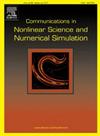广义牛顿流的时空高阶动态非线性变分多尺度方法
IF 3.4
2区 数学
Q1 MATHEMATICS, APPLIED
Communications in Nonlinear Science and Numerical Simulation
Pub Date : 2024-09-26
DOI:10.1016/j.cnsns.2024.108368
引用次数: 0
摘要
非牛顿流体在工业领域、生物问题和其他自然现象中都备受关注。这项研究提出了流变学依赖性、空间和时间上的高阶非残差稳定有限元公式。通过处理高度对流的时间依赖性幂律流,评估了这些方法的准确性。空间近似使用拉格朗日有限元,最高可达四阶。时间积分通过一阶、二阶和三阶的反向微分公式完成。我们工作的一个关键方面是使用非剩余正交变分多尺度(VMS)公式来稳定主导对流,并允许对速度和压力进行等阶插值。我们的 VMS 方法使用动态非线性子尺度,迄今为止尚未对广义牛顿流体进行过测试。在这项工作中,我们系统地评估了使用高阶时间离散的子尺度组件。数值实验考虑了在雷诺数介于 40 和 400 之间、幂律指数介于 0.4 和 1.8 之间的密闭圆柱体上的流动。数值测试表明,该方法在所有空间和时间阶数组合中都很稳定。我们的结果表明,使用高阶空间离散可以更精确地近似边界层和粘度场。此外,更高的时间阶数允许使用更大的时间步长,同时仍能捕捉高动态行为,并获得更好的频谱分辨率。本文章由计算机程序翻译,如有差异,请以英文原文为准。
Spatially and temporally high-order dynamic nonlinear variational multiscale methods for generalized Newtonian flows
Non-Newtonian fluids are of interest in industrial sectors, biological problems and other natural phenomena. This work proposes rheologically-dependent, spatially and temporally high-order non-residual stabilized finite element formulations. The accuracy of the methods is assessed by tackling highly-convective time-dependent power-law flows. The spatial approximation uses Lagrangian finite elements up to fourth order. The temporal integration is done via backward differentiation formulas of order one, two and three. A key aspect of our work is using a non-residual orthogonal variational multiscale (VMS) formulation to stabilize dominant convection and to allow equal-order interpolation of velocity and pressure. Our VMS method uses dynamic nonlinear subscales, which have not been tested so far for generalized Newtonian fluids. In this work, the use of high-order temporal discretizations for the subscale components is systematically evaluated. Numerical experiments consider the flow over a confined cylinder for Reynolds numbers between 40 and 400 and power-law indices between 0.4 and 1.8. Numerical testing demonstrates the method to be stable in all combinations of spatial and temporal orders. Our results show that using high-order spatial discretizations more accurately approximates boundary layers and viscosity fields. Moreover, higher temporal orders allow using larger time steps while still capturing highly dynamic behaviors with better resolution in frequency spectra.
求助全文
通过发布文献求助,成功后即可免费获取论文全文。
去求助
来源期刊

Communications in Nonlinear Science and Numerical Simulation
MATHEMATICS, APPLIED-MATHEMATICS, INTERDISCIPLINARY APPLICATIONS
CiteScore
6.80
自引率
7.70%
发文量
378
审稿时长
78 days
期刊介绍:
The journal publishes original research findings on experimental observation, mathematical modeling, theoretical analysis and numerical simulation, for more accurate description, better prediction or novel application, of nonlinear phenomena in science and engineering. It offers a venue for researchers to make rapid exchange of ideas and techniques in nonlinear science and complexity.
The submission of manuscripts with cross-disciplinary approaches in nonlinear science and complexity is particularly encouraged.
Topics of interest:
Nonlinear differential or delay equations, Lie group analysis and asymptotic methods, Discontinuous systems, Fractals, Fractional calculus and dynamics, Nonlinear effects in quantum mechanics, Nonlinear stochastic processes, Experimental nonlinear science, Time-series and signal analysis, Computational methods and simulations in nonlinear science and engineering, Control of dynamical systems, Synchronization, Lyapunov analysis, High-dimensional chaos and turbulence, Chaos in Hamiltonian systems, Integrable systems and solitons, Collective behavior in many-body systems, Biological physics and networks, Nonlinear mechanical systems, Complex systems and complexity.
No length limitation for contributions is set, but only concisely written manuscripts are published. Brief papers are published on the basis of Rapid Communications. Discussions of previously published papers are welcome.
 求助内容:
求助内容: 应助结果提醒方式:
应助结果提醒方式:


